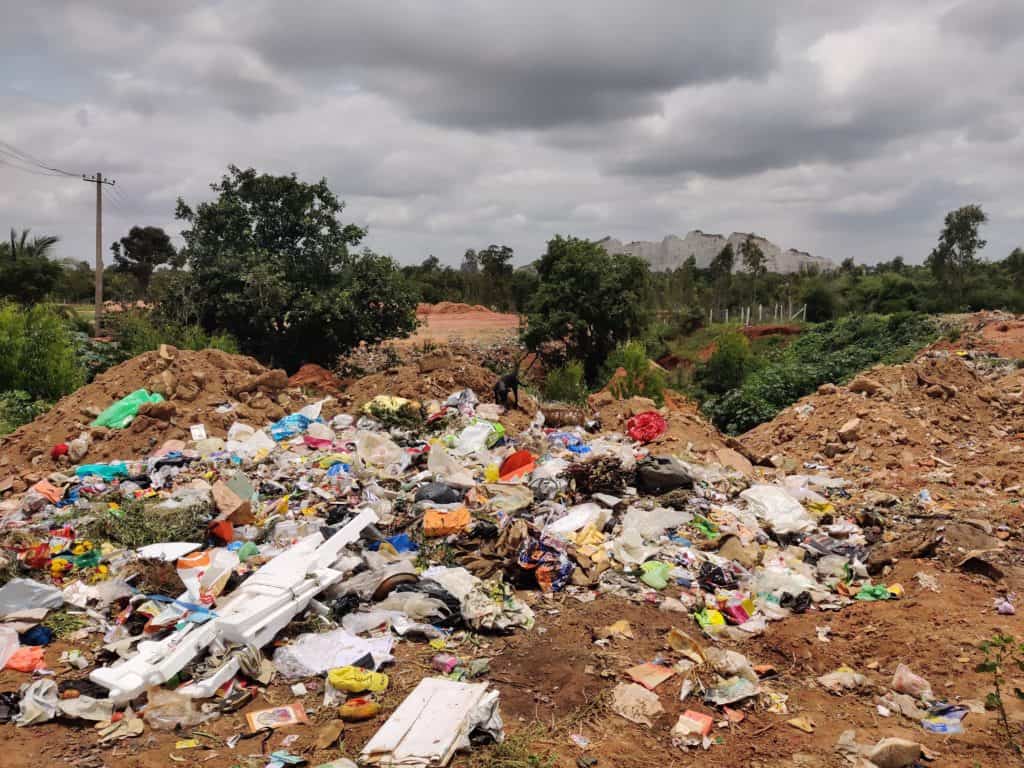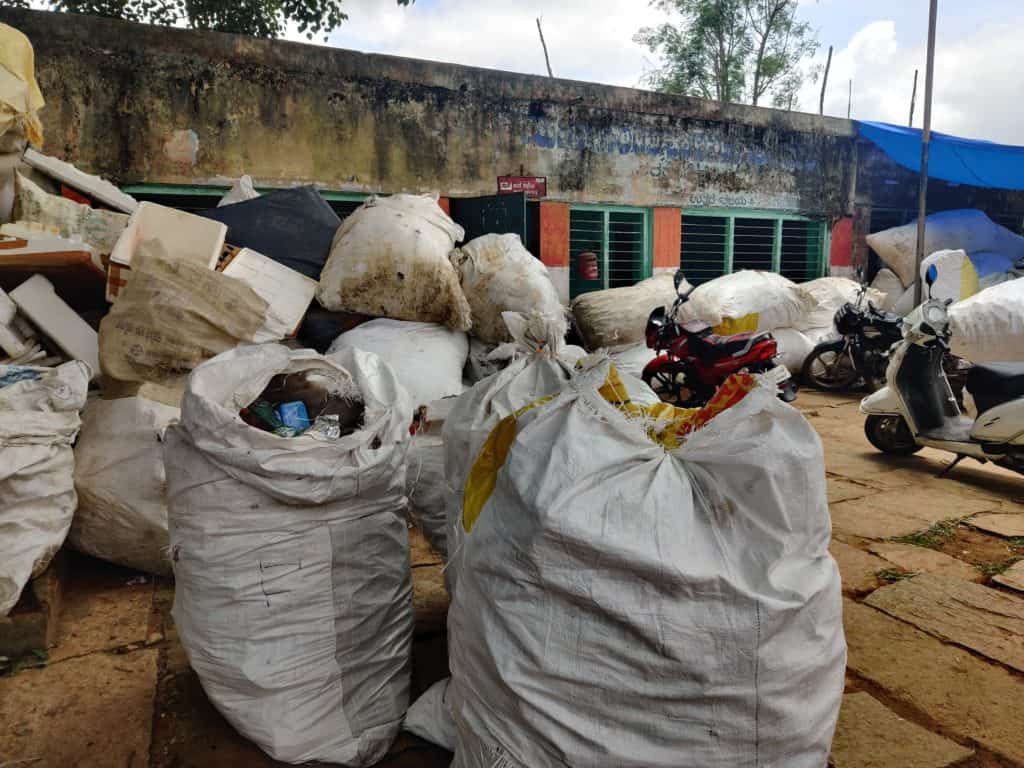A few years ago, if you were to drive off the airport road towards Bettahalasur, 30 km away from Bengaluru, you would find mounds of garbage littered around. The village did not have a functioning system of waste management.
Littering was common practice and waste management was practically unknown. Garbage from approximately 2500 households, totalling about 53 tonnes per month, was dumped or burnt in the panchayat, causing air, water and soil pollution.

But all this changed in June 2016, with the launch of the EcoGram Project, by the The Anonymous Indian Charitable Trust (TAICT). TAICT was founded by Myriam Shankar, to address the interconnected issues of waste, water and soil management.
How it all started
Myriam, who now identifies as Indian, first visited India in 1992 and fell in love with the country. When she returned in 2002, garbage littered around the countryside and the city bothered her, and she wanted to do something about it.
In 2009, she launched the Let’s Clean Bangalore campaign, which envisioned freedom from garbage. However, the campaign fell short, as she realised that clean-up drives in the city were only a temporary solution, which still resulted in dumping in villages.
Myriam says, “It’s unfortunate that we are wasting our waste. Waste is a resource that has been put in the wrong place, polluting our very foundation to good health.” She launched the Solid Waste Management Roundtable (SWMRT) – a platform to promote decentralised waste management – in 2009, but moved out in 2018. In 2016, after being actively involved in the public interest litigation (PIL) on making waste segregation mandatory, she decided to put the concept into practice.
She started putting in place an end-to-end waste management system in Bettahalasur Gram Panchayat north of Bengaluru, in partnership with the local community and with CSR funding from the Embassy Group.
What was the process followed?
Myriam says they started off with a comprehensive baseline survey to assess the number and type of waste generators and the type of waste. Then awareness sessions on the 2Bin1Bag method of segregation were held for 2,232 waste generators, across 9 out of the 10 villages that come under the gram panchayat.
Read more: How the 2Bin1Bag initiative helped Bengaluru score high in waste segregation
“The next step was to implement stream-based door-to door waste collection,” Myriam says. “We provided alternate-day collection of organic (wet), recyclable (dry), sanitary/reject and mixed waste for all villages. For this, the team selected a suitable waste management operator (Hasiru Dala Innovations) which was willing to follow TAICT’s philosophy, that no waste should be left behind in the locality.”
The team bought suitable vehicles that could collect and carry waste streams separately. The operations are monitored weekly, based on the following 15 key performance indicators (KPIs):
- Segregation at source
- Recovery of dry waste
- Participation level of waste generators/households
- Coverage of door-to-door collection in each route
- Coverage of door-to-door collection from waste generators
- Incident reports (such as non-pick up of waste)
- E-waste management
- Sanitary waste management
- Mixed waste management
- Low-value waste management
- Ratio of organic and brown matter, which indicates the quality of composting
- Amount of compost harvested
- Employee attendance
- Employee feedback
- Extent of cost recovery for SWM services
Archana Prasad Kashyap, Program and Communications Lead at TAICT, says, “We have biometric units installed for team attendance, and GPS fleet-tracking software and hardware for all vehicles. Supervisors have been trained on data entry in Excel templates created by TAICT.”
The project also piloted the ‘Waste Samaritan’ app three years ago. In this app, every waste generator is given a unique ID that is scanned using a QR code every time waste is collected from their doorstep. With the app, “2232 waste generators are currently being tracked for the quality of segregation, participation and monitoring. In addition, the app is also being used for door-to-door surveys,” says Archana.
There is also a special arrangement for waste management during village jatre festivals. In addition, Myriam says, “Waste generators are being held accountable to have special event management for any event attended by more than 100 people.”
The team regularly conducts awareness sessions across age groups. All school students go through annual refresher workshops based on the ‘Trashonomics’ book co-authored by Archana. Training on sustainable menstruation is conducted regularly for all women. The team has also institutionalised the concept of having EcoGram Ambassadors who help promote the vision of the project. A women’s group named EcoGram Shakti Sisterhood has been trained on various life skills, and they promote the project by distributing 2bin1bag kits, through clean-up drives, etc.
Infrastructure set-up
The team has three vehicles (two owned by TAICT and one rented), operated by Hasiru Dala Innovations (HDI) for nine villages. All organic waste is shredded and composted in windrows. The gram panchayat also houses a dry waste collection centre (DWCC) which is managed by HDI.

Marwan Abubaker, Co-founder of HDI, says that the collected dry waste is segregated into 35-40 categories at the centre. Five years into the project, the Karnataka government has allocated land to set up an Integrated Waste Management Centre for the project, named EcoHub.
The impact
“Earlier, our village residents used to dump waste on roadsides, which affected my cows’ health. I am very happy that after EcoGram started operations in our village, roadside littering and burning of waste has completely stopped,” says Dushyant, a resident of Sugatta village.
The number of residents complying with segregation has steadily increased, going up to 94% in 2020. “Behaviour change needs to be constantly reinforced, and supplemented with user-friendly equipment, starting from colour-coded bins at the household level, or community bins in areas where door-to-door collection is a challenge for logistical reasons,” says Myriam. “This, combined with strict monitoring, is the only way to achieve a cleaner locality. And this comes at a cost! This needs to be factored in when projecting user fees.” Currently, HDI is unable to cover operating costs through the user fee alone, and relies on CSR funding by the Embassy Group.
However, Myriam says that, even at the remarkable level of 94% segregation, they see several categories of waste that have no sustainable solution in India currently. These include materials like Multi-Layered Plastic, cloth, shoes, mattresses, e-waste and household hazardous waste.
“There is a desperate need by the lawmakers to recognise this, and to provide the waste management industry with more solutions and infrastructure, like funding for recycling, R&D, large recycling parks for the informal sector (so that this incredible workforce can be galvanised),” says Myriam. “The current state of affairs in which unwanted waste gets dumped is not sustainable, as volumes are progressing. It adds too much pressure on the land which should not be used to house garbage, but to feed people.”
The following table indicates how HDI’s collection of segregated waste – dry, wet and sanitary – have increased over the years, whereas mixed (unsegregated) waste collection has reduced. The table also shows the number of trees, landfill area, and the amount of fuel and energy saved, based on this calculator.
| 2016 | 2017 | 2018 | 2019 | 2020 | Total so far | |
|---|---|---|---|---|---|---|
| Number of waste generators involved | 471 | 564 | 996 | 1,583 | 1,876 | – |
| Dry waste collected annually | 5,109 kg | 19,027 kg | 48,731 kg | 1,07,428 kg | 1,21,021 kg | 301 MT |
| Wet waste | 6,546 kg | 15,672 kg | 46,731 kg | 1,20,109 kg | 1,34,426 kg | 323MT |
| Sanitary/Reject waste | – | – | 429 kg | 3,914 kg | 15,830 kg | 20 MT |
| Mixed waste | – | – | 23,339 kg | 33,235 kg | 17,056 kg | 81 MT |
| Segregation level | – | – | 80.33% | 87.44% | 94.08% | – |
| Dry waste recycled (in tonnes) | 5 | 19 | 48 | 72 | 110 | 254 MT |
| Number of trees saved | 39 | 144 | 365 | 553 | 587 | 1,688 |
| Landfill area saved (in cubic metres) | 63 | 222 | 571 | 929 | 1,342 | 3,127 |
| Fuel saved (in kilo litres) | 6 | 22 | 54 | 81 | 106 | 269 |
| Energy Saved (in MWh) | 13 | 47 | 119 | 180 | 235 | 594 |
Myriam says, “In order to make it sustainable as per law, and balance out the need for planning and oversight, the next step is to create institutional memory for the gram panchayat. They need to pass SWM bye laws and constitute a sanitation and health committee which will oversee operations as representatives of the panchayat.”
What elements are required to replicate this model in other villages?
- Baseline survey
- Door-to-door awareness on 2bin1Bag; know your customers
- Enlisting support of elected representatives and local officials, and holding capacity-building exercises for them
- Building trust in the community, engaging with residents on community-based activities
- Plan for waste-stream destinations – invest in necessary infrastructure and data management
- Streamline collection and transportation
- Institutionalise the process by passing necessary circulars and orders, including penalties
- Initial funding to streamline operations through CSR/EPR (Extended Producer Responsibility) and government, for seamless transactions
- Constant training and engagement
- Grievance redressal mechanism
- Monitoring and evaluation
- Collective problem solving
- Awards and recognition
What can Bengaluru learn from Bettahalasur?
Myriam believes Bengaluru needs to be more proactive: “The key to efficiency is good segregation. And to put the focus on good segregation, we need end-to-end waste management services. That is, from generators to waste-stream destinations”.
Marwan adds, “The BBMP has very good laws on paper. The main challenge is in translating the same into practice.” One of the most important factors in the EcoGram project is data management, he says. “We are able to identify the number of residents in each village and assess the quality of segregation through the Waste Samaritan app. Bengaluru needs to invest in updated data capturing, ensure every household is serviced, followed by strict compliance monitoring.”
Read more: How to manage waste in Panchayat limits: lessons from BIAL area
Echoing similar thoughts, Kashyap says, “Waste management is a utility service and the first step is to know your customer and ensure every customer is being serviced. Without this first step, Bengaluru may reach its goal of close to 100% waste segregation from customers it’s servicing, but never reach its goal of collecting from 100% of citizens.”
Myriam says, “Unfortunately, in Bengaluru a lot of waste is currently dumped. It is high time to invest in research and development, and the Karnataka State Pollution Control Board needs to ramp up its capacity to guide and monitor the operations of the BBMP.” She adds that the efficiency and willingness of the operator is also critical. “A good operator will need to engage with waste generators, plan for collection in areas where door-to-door is not possible, work with the community on placing litter bins, identify defaulters, provide status reports and participate in social audits . The system will need to be dynamic and will have to be institutionalised.”